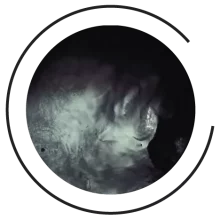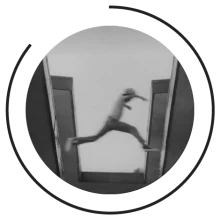Assembly & Disassembly

Before Time and Space
This sequence presents the early universe before extended causal regions of Time and Space were created in the Big Bang. The timeless, spaceless, and unobservable universe is visualized according to the research ideas of Princeton physicist Chris Tully, using a slightly transformed long take from Tarkovsky’s Stalker (1979).

Big Bang
The singular event of the original “disassembly” produced Matter and Light, and expanded causally connected Time and Space – the very conditions of architectonic assembly.

Cosmic Architectonics
Telescopic images of NASA and quotations from Stanley Kubrick’s 2001: A Space Odyssey (1968) are transformed into a sequence of time travel from the Big Bang through the early architectonics of filaments and the birth of gravitating clusters of matter to the assembly of the planetary system in the late universe. Cosmic assembly continues to coincide with disassembly: explosions and high impact collisions are productive of matter and of the renewal of conditions of architectonic assembly.

The Hubris of Architecture
Architecture was held up by Hegel as proof for the supremacy of Western civilization on account of its spectacular achievements in constructing seemingly permanent stability. The delusional, albeit heroic pursuit of conquering gravity through the aggressive entrenchment of a rigid balance, however, makes the toppling of these structures inevitable. Michelangelo Antonioni’s emblem for architectural hubris in his Zabriskie Point (1970) is a modernist villa appropriating indigenous cultures, scarce natural resources, and a prehistoric landscape assembled fifty million years ago.

Hot Disassembly
Antonioni’s vision of the disassembly of Western civilization is not a prophecy of our future, rather an acute analysis of our present. Consumer goods cluttering Western life are experienced as interminable spectacular explosions of rubble.

Vitruvian Child
The choreography of the fluid architectonics with kids leaping over the rooftops of the LA projects in Watts is developed from an image of Charles Burnett’s Killer of Sheep (1978). A non-delusional conquest of gravity is possible by a transient act of balancing that uses the ground not for the entrenchment of a rigid equilibrium but for take-off, touch-down, and the levity of the curved flight in between. The Vitruvian Child is the cinematic counterpart of Leonardo’s Vitruvian Man. The leaping child escapes the classic orthogonal box of the fixed single point perspective.

Cold Disassembly
In contrast with Antonioni’s vision of a spectacular disassembly of Western civilization, the Eastern European Andrei Tarkovsky’s cinematic representation of the present predicament of human civilization in Stalker is a calm disassembly submerged under water. The sequences are looped with no end or beginning.
Plato's cave

Standing under the center of the Angelus Novus Vault in the garden of Palazzo Mora in Venice while holding up a mobile device equipped with the Plato’s Cave App, one can see the inside of Brunelleschi’s dome of the Santa Maria del Fiore. The inside of the augmented reality dome is “painted” with the animated mashup of the original Vasari fresco depicting The Last Judgement and Kiss’s Assembly/Disassembly. The augmented reality experience via the Plato’s Cave App reveals the coincidence of the self-balancing architectonics in Brunelleschi’s curved space engineering, in Vasari’s vision of Dante’s non-Euclidean, spherical cosmology and in the perfect moral balance of The Last Judgement.



